As Consumers Shift Toward Conscious Companies, Communication Is King
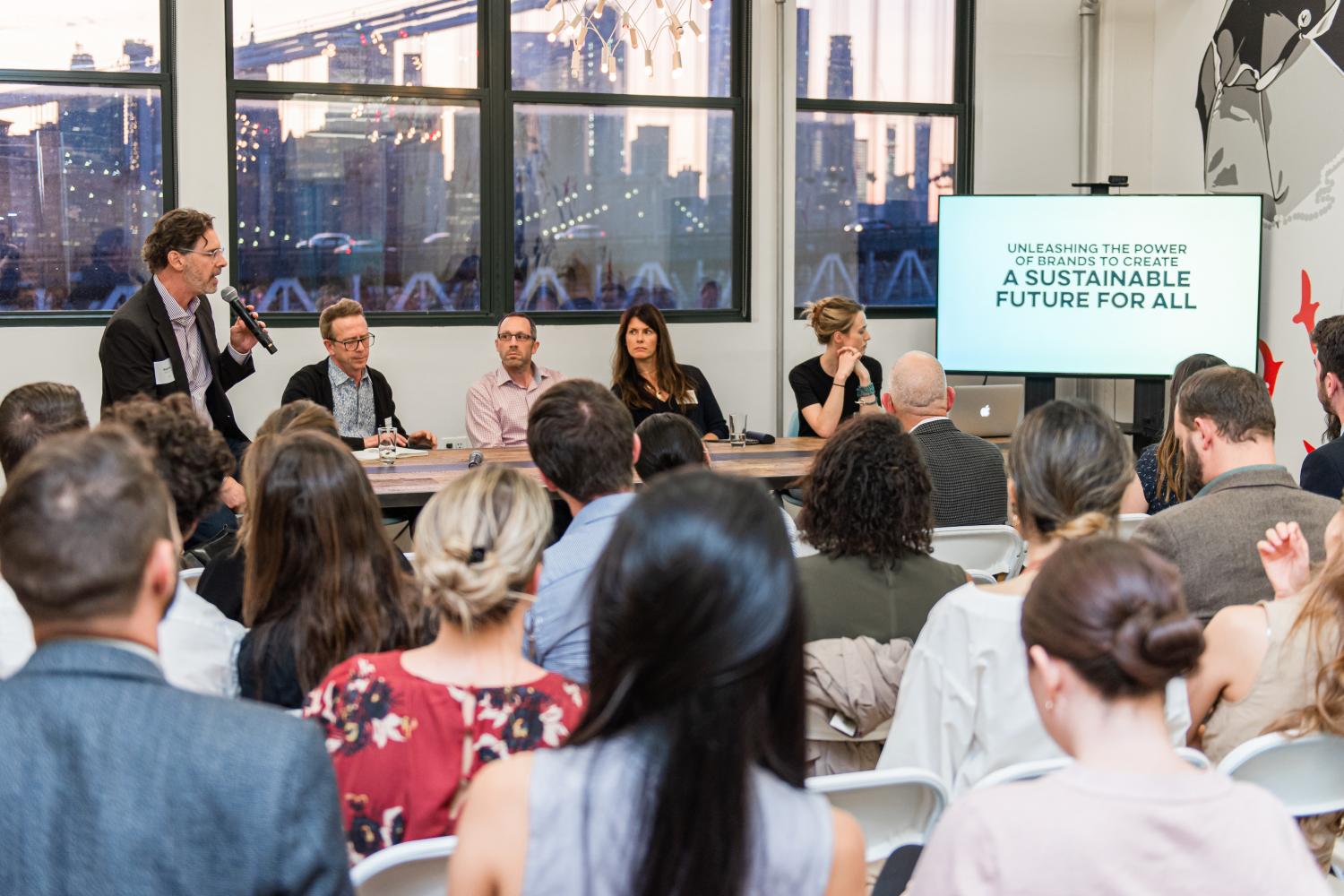

(Image: Apparel industry insiders discuss sustainability and sustainability communication at a side event during Climate Week NYC.)
Life in 1950s America is perhaps best characterized by the popular idiom “keeping up with the Joneses.” Social status was, in large part, determined by accumulation of material goods, as families strived to purchase that new washer and dryer or television set before the neighbors next door.
In the more than six decades since, our march toward a consumer-driven economy has ballooned into a make, take and dispose system dominated by single-use goods that now fill landfills and spill out into our oceans. But after decades of “buy, buy, buy,” research indicates that Americans may be ready for a change.
Case in point: Brand and social innovation consultancy BBMG recently surveyed more than 2,000 Americans to find out what matters most to their quality of life. More than 9 in 10 (95 percent) said that “having meaningful relationships with others” is what’s most important, while just half said the same about “having a lot of money” (54 percent) or “being able to afford luxury goods” (44 percent).
People were also more inclined to rank “achieving overall happiness despite life’s challenges” and “living a healthy, balanced life” over traditional status symbols like “owning a home” or “owning a car.”
“If that’s what consumers want, how do we use the power and influence of brands to solve for it?” Raphael Bemporad, founder of BBMG, said at a side event co-hosted with 3BL Media during Climate Week. “As a consequence of our consumption economy, we now have a planet in peril, we face rising income inequality, and in many ways we’re at a tipping point of what’s going to happen to our species.”
At BBMG’s headquarters in Brooklyn, Bemporad spoke alongside industry leaders from the apparel industry, who discussed how this sector is addressing market shifts toward “meaning over materialism.” It’s fitting, really, as the fashion industry is arguably both at the epicenter of our consumption culture and among those most attuned to changing consumer appetites.
“This is one of those industries that is super responsive to culture,” said Matt Jacobs, sustainability officer for Darn Tough, a sock company based in Vermont. “It’s probably more able to change than any other industry I see out there because it is so responsive and dictated by what the consumer demands.”
Consumers are looking for sustainability and social impact
Although consumers continue to seek out standard product characteristics like value and convenience, sustainability and social impact are emerging as key differentiators, according to BBMG’s research.
In other words: When deciding between similar products, more consumers will choose the item that leaves less impact on people and the planet. In particular, respondents said they’re more likely to buy a product that is traced to origin or locally made, bears an environmental label, or supports a cause they believe in.
“Sustainability is increasing in importance and going toward an upward trend,” said Jeannette Ferran Astorga, vice president of corporate responsibility for Ascena Retail Group, the parent company behind brands like Ann Taylor, Loft and Lane Bryant. “Brands that are starting to become known as change-makers are the ones that are going to resonate.”
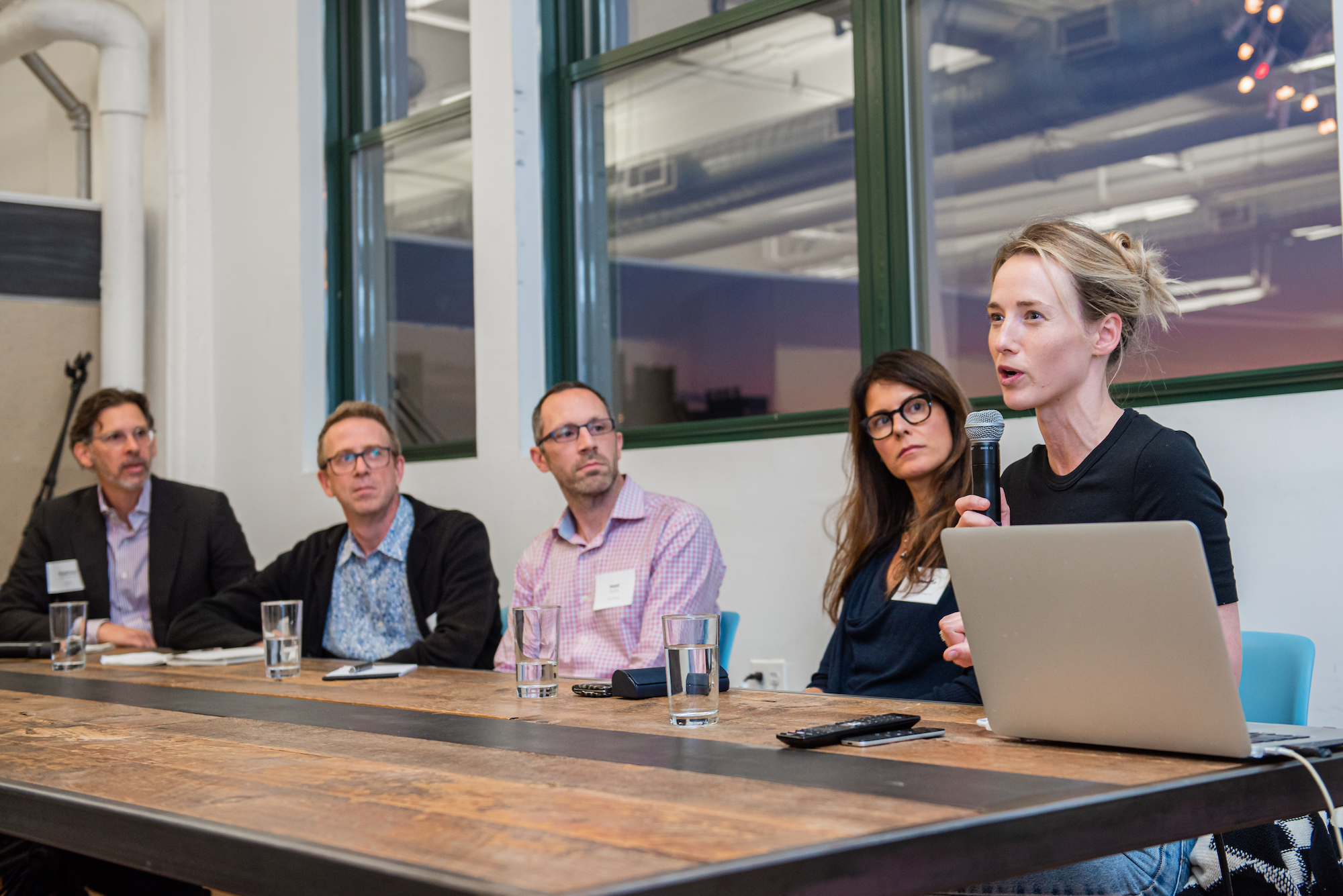
(Image: From left to right: BBMG founder Raphael Bemporad, Jean-Emmanuel Shein of Uniqlo, Matt Jacobs of Darn Tough, Jeannette Ferran Astorga of Ascena Retail Group, and Natasha Franck of Eon Group discuss sustainability in the fashion sector at BBMG headquarters in Brooklyn, New York.)
Sustainability communication is king: Are brands ready?
In short: As people become more aware of the threats overconsumption poses to communities and the environment, from human rights abuses in corporate supply chains to pollution, ecosystem degradation and climate change, they’re looking to make some changes to what they buy—and who they buy from.
The companies that will win out are not only the ones doing the right thing, but those that can communicate what they’re doing effectively. But making heads or tails of effective sustainability communication is a challenge that still vexes many brands.
Darn Tough, for example, has prided itself on being a good corporate citizen in its community of Northfield, Vermont, since it launched as Cabot Hosiery in 1978. The company, which transitioned from a private-label purveyor for large fashion retailers to its own brand in 2004, still makes all of its socks in Vermont and carefully tracks its environmental impact to avoid polluting the local community.
For Darn Tough’s founders, it’s all a part of doing business, but that presents a disconnect when it comes to communication.
“We’re a brand that is, frankly, run by folks in the older generation who think it looks self effacing to talk about this stuff,” Jacobs said. “They think it looks like bragging …. [and they] don’t look favorably upon those types of communications. But younger generations think that if you're not communicating about [your impact], you must be hiding something. That's a real conundrum for us to deal with as a brand.”
Jean-Emmanuel Shein, global director of sustainability for Uniqlo, a global fashion brand based in Japan, described a similar disconnect, along cultural rather than generational lines. The company’s push toward more sustainable denim is one it’s sharing loudly and proudly, but this type of communication is rare for Uniqlo, Shein said.
“We’re very humble. We don’t shout. And we rarely commit to things unless we’re ready to go 100 percent, because falling short would be seen as dishonorable and like we’re cheating our customers,” he explained in New York last week.
But for large companies in particular, overcoming philosophical barriers around sustainability communication is only half the battle. When it comes to tracking the impact of each product and sharing it with customers, many global brands simply don’t have the data, said Natasha Franck, founder and CEO of Eon Group, which leverages technology to develop circular economy solutions for fashion brands.
"One of the brands we work with recently shared with us that they do a great job of communicating sustainability in a sustainability report, but it's actually very hard to have data about a product and its sustainability at point of purchase,” Franck explained. “For the brands doing this at scale, that's a lot of data to manage. We see massive new opportunities to connect that product from a sustainability perspective with data, so information about each item is available at point of purchase, not just in a [corporate responsibility] report.”
Mastering the art of sustainability communication
Increasingly, eco-labels like the Better Cotton Initiative seal, the BlueSign standard and Fair Trade certification give apparel brands more options for tracking—and communicating—their commitment to workers and the environment. And industry-wide collaborations such as the Sustainable Apparel Coalition (SAC) make space for brands to learn from one another.
Brands continue to jump on board, as the SAC now counts nearly 250 apparel, footwear and textile companies among its membership. And they'll likely continue in this direction, as consumers continue to demand it. Because, in the end, what brands do—and how they talk about it—will be driven by consumers, the industry experts predicted.
"People want the nutrition label on their jacket or their shirt, and brands respond to that," Jacobs said. "This is an industry that responds to you. Every line of clothing that you see is dictated by you. So, my ask is that consumers push us. Push these brands to do more, to respond more—and they'll respond."
Image credits: Vitaliy Piltser
Standing Up for Climate Refugees In Latin America
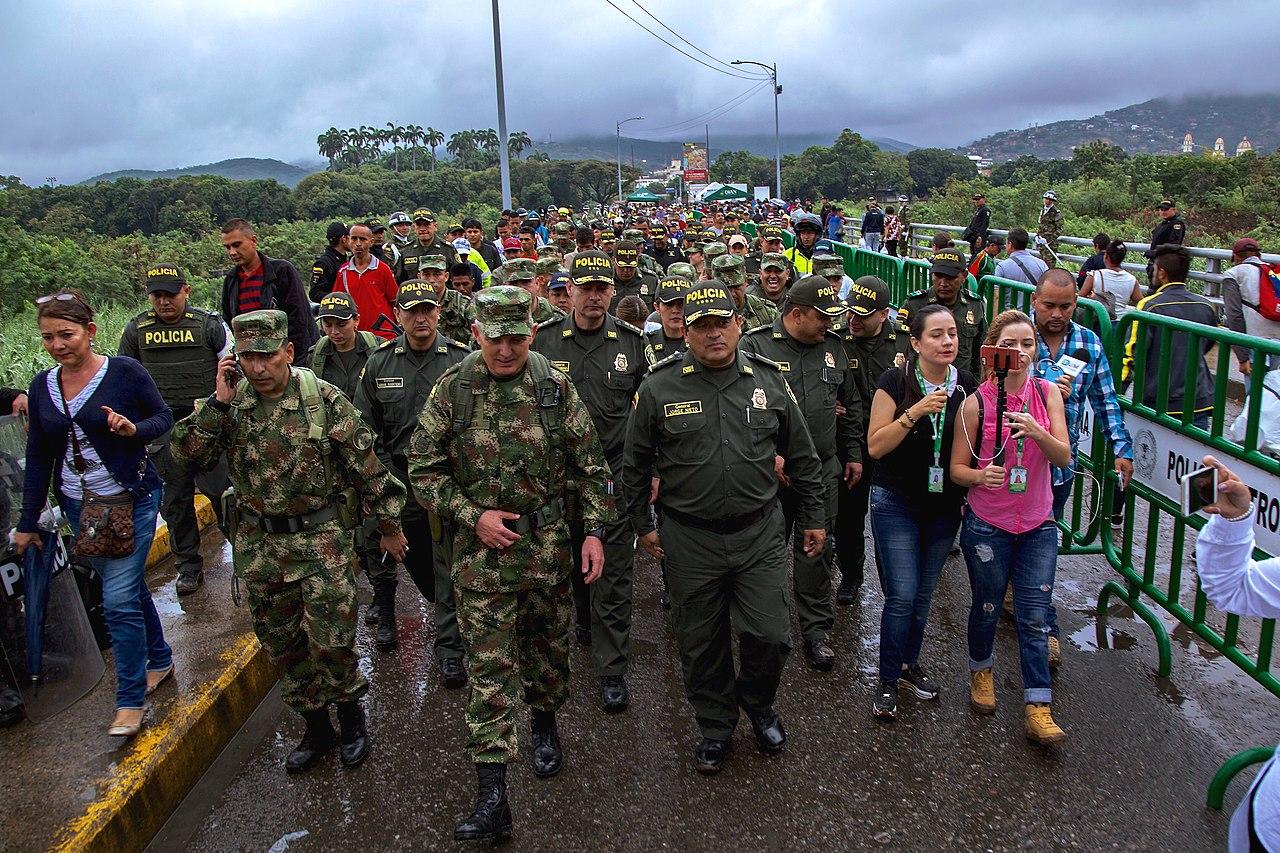

The plight of climate refugees is becoming more dire across the globe. This crisis is not going away any time soon, no matter what the U.S. and other nations do to harden their borders. A more sustainable, holistic solution is needed, and the nonprofit organization Tent Partnership for Refugees has set a course that puts corporate leadership on the front lines for action.
The Tent Partnership for Refugees and next-level corporate responsibility
Tent launched in 2016, in response to a “Call for Action” issued by then-President Barack Obama. President Obama urged corporate leaders to provide help by applying their own knowledge base and corporate resources to the problem, rather than simply providing cash grants to third parties.
That hands-on, collaborative approach to corporate charity has been gathering steam in recent years, and Tent rapidly attracted interest. More than 100 companies currently participate in Tent, including Accenture, IBM, KPMG, Sodexo and Starbucks. These companies use Tent as a platform for sharing best practices, and for enlisting additional support.
The crisis grows for climate refugees in Latin America
Tent’s latest initiative focuses on the refugee crisis in Latin America. In particular, the organization is focusing on aid for countries that are hosting refugees from Venezuela, where severe drought has contributed to both political and economic upheaval, leading millions to flee the country.
To get a handle on the scope of the problem, Tent engaged in a research project with the firm GBAO Strategies. The project included interviews with 600 refugees from Venezuela living in Colombia and Peru.
The interviews provide ample support for the view that the climate refugee crisis is a long-term trend that will continue to grow. As described by Tent, the research shows that “Venezuelans are likely to continue to flee in substantial numbers,” and those who have already fled are unlikely to return for many years.
An untapped talent pool
Colombia, Peru and other countries in the region have been accepting refugees from Venezuela (as shown in the photo of Colombian police escorting Venezuelan refugees across the nation’s northeastern border), but they are reaching their capacity to absorb the flood of new job seekers.
Though the host countries are doing a relatively good job of meeting the basic needs of refugees, the Tent survey revealed that most refugees are unable to integrate into the local economy.
Work is widely available, but salaries are “meager,” and access to health care, banking and other key services is also limited.
The survey did find one key to a potential solution. It found that just one in six Venezuelans were in the same field as they were in Venezuela, indicating that refugee host countries could be sitting on a pool of new talent that could help stimulate economic growth, if productively applied.
Creating jobs and entrepreneurial opportunities for climate refugees
Tent is zeroing in on the skill sets angle, in partnership with the Luis Alberto Moreno of the Inter-American Development Bank and Hamdi Ulukaya, the owner, founder, chairman and CEO of the popular U.S.-based yogurt brand Chobani.
The idea is to encourage leading companies to create thousands of new jobs in host countries and provide more support for local businesses.
The effort launched on September 23 with commitments from more than 20 companies including Airbnb, Telefonica, Teleperformance and Sodexo.
The initial commitment totals more than 4,500 new jobs for refugees and support for more 2,000 refugee-owned businesses. The participating companies have also pledged to improve access to services for more than 110,000 refugees.
In a press release announcing the new initiative, Ulukaya emphasized the opportunity for economic growth in the host country.
“Refugee passion and perseverance is just waiting to be unlocked,” he said. “When given the chance, refugees will make your companies stronger, smarter and faster. But it’s up to us to open the door and provide the opportunity for human dignity.”
How 20 years of diplomacy set the stage
The Tent initiative provides businesses with a solid, bottom line opportunity to grow their operations while providing solutions to a global crisis.
There is much more to the story, though. One additional thread concerns Colombia itself. During the Bloomberg Global Business Forum in New York City last week, participants in a public panel discussed how Colombia has shed its violent past, and has created a more welcoming, secure environment for leading businesses.
The panelists — including former U.S. President Bill Clinton and current Colombia President Iván Duque Márquez — described a decades-long diplomatic effort, spearheaded by the U.S., that enabled Colombia to reduce drug crime and stabilize its political situation.
Without that groundwork, the new Tent initiative would have little to offer companies that are willing to invest in Colombia.
The refugee crisis and a green new deal for Latin America?
Another important thread concerns Colombia’s decision to adopt the mantle of a regional environmental trailblazer. During the discussion, President Duque cited a long list of accomplishments, including a clampdown on illegal deforestation and a multi-nation pact to protect the Amazon.
That strategy has also contributed to the country’s ability to attract investors, as affirmed by panelist Bruce Flatt, CEO of Brookfield Asset Management. Flatt emphasized that the company is highly selective about the countries in which it does business.
Among Brookfield’s criteria is respect for international standards, and Colombia’s position as an environmental leader has placed it in a good position to take advantage of the emerging global consensus on climate action.
Federica Mogherini, who is Vice President of the European Commission, was also on the panel. She underscored the importance of job creation for current citizens as well as refugees.
Mogherini pointed out that Colombia’s progress on making peace with the rebel group FARC has helped to attract public sector investment as well as private sector interest.
“Job creation is part of the success story of the peace implementation with FARC,” she explained. “Disarmament needs to be supported and sustained.”
Climate refugees and the global battle for democracy
As President Clinton emphasized, Colombia is emerging as a test case for countries to host climate refugees as part of a sustainable development plan.
In that regard, Colombia is also a test for the ability of democratic governments to create new green jobs.
Clinton pointed out that Colombia is “committed to a green energy future that doesn’t destroy the world on the rocks of climate change.”
“There is no better test of democracy today than Colombia,” he said. “Colombia is embracing more democracy, not less. They are embracing their neighbors, not turning them away. They are bucking the xenophobic trend around the world.”
Don’t forget: Later this month, we’ll be hosting 3BL Forum: Brands Taking Stands – What's Next, October 29-30, at MGM National Harbor, just outside Washington, D.C. Included in our lineup of 90-plus speakers will be a conversation on what disasters can tell us about the climate crisis and resilience planning.
We're pleased to offer 3p readers a 25 percent discount on attending the Forum. Please register by going to the 3BL Forum website and use this discount code when prompted: NEWS2019BRANDS.
Image credit: Policia Nacional de Colombia/Wiki Commons
Why Female Board Representation Does (And Does Not) Matter

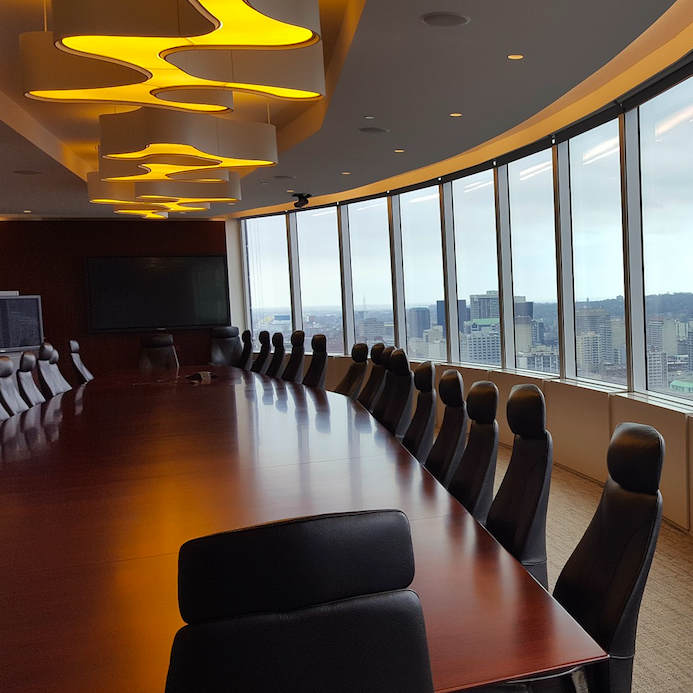
A growing body of behavioral research is illustrating how the old adage, “pride goeth before a fall,” applies to top corporate leadership. Overconfidence is the key factor that drives CEOs — predominantly male CEOs — to underestimate risks and make rash decisions with negative bottom line consequences. A new study published in the Harvard Business Review adds an interesting gender-based twist: corporate boards that include women are more likely to exercise a beneficial, moderating influence on male CEOs.
Overconfidence and the gender factor
To be clear, the new research does not make the case that women act as moderating influences because they are less confident. Quite the opposite.
“One benefit of having female directors on the board is a greater diversity of viewpoints, which is purported to improve the quality of board deliberations, especially when complex issues are involved, because different perspectives can increase the amount of information available,” the authors explain.
They also emphasize previous research that supports other elements of strength and confidence that women directors tend to possess. That includes a tendency to be less conformist and more independent in thinking.
Interestingly, the authors point out that independent thinking is linked to the absence of a supportive “old-boy” network, in which insiders are reluctant to challenge each other.
The result is that female directors tend to be more confident about challenging a male CEO’s decisions.
Risk, gender and climate change
The new study also has some implications for the ability of corporations to switch gears and adopt new strategies that address the risks of climate change.
The authors chose to study CEO behavior from 1998 to 2013, a period when women in top positions were a rarity. In the study sample, women accounted for only 2.9 percent of CEOs and 10.4 percent of board members overall.
As an indicator of overconfidence, the authors examined how CEOs in the study sample exercised stock options.
Overconfidence is evident among CEOs who continue to hold their options when the market price is already high. They anticipate even higher gains in the future, a gamble that does not always turn out well.
After controlling for other factors, the survey showed that male CEOs were less likely to continue holding options when women were present on their board.
“…we did find that having at least one female director on the board was associated with less aggressive investment policies, better acquisition decisions, and ultimately improved firm performance in these industries,” the authors conclude.
They also found that female representation on boards correlated with the ability of companies to manage risk during the peak years of the financial crisis, from 2007 to 2009. The findings suggest that these companies were exposed to less risk in the run-up to the market collapse.
As for climate change and climate action, the authors also note that the degree of overconfidence varied significantly by sector. For example, the female factor was not evident in the utility and telecom sectors, possibly because those sectors tend to attract CEOs with a more cautious character.
How overconfidence contributed to the decline of coal
Significantly, the authors identified coal as one of the sectors in which male overconfidence was most evident.
The coal industry has been marked by a lack of gender diversity throughout its history. Coincidentally or not, coal CEOs have been caught flat-footed as the global economy pivots to cleaner energy.
The gender problem for coal goes beyond corporate risk taking. By failing to recruit a diversified workforce and failing to promote women from within, coal is also falling behind in the global talent race.
Here in the U.S., regardless of public policy the up-and-coming workforce is more diverse and more likely to take climate risks seriously.
That leaves coal companies with a rapidly shrinking pool of talent to draw from, while facing increased competition for talent in the burgeoning renewable energy field.
Tech companies also have some explaining to do
The authors also found that CEOs within the information technology space were also susceptible to overconfidence.
That tendency still appears to be resonating today in the context of climate action. Industry observers are beginning to notice that, as a group, tech leaders are not responding to climate change in proportion to the power they wield over the global economy.
Last summer, the Financial Times published an op-ed that summarized the situation:
“…few of Silicon Valley’s amazing achievements have had a bearing on climate change. The world’s most innovative place lacks answers to the world’s existential problem. The contrast is striking, given that many tech employees worry about the issue.”
Fast Company also looked at the issue last summer and took a more nuanced approach, arguing that tech companies have taken some important steps to reduce their carbon footprints, but as a group they have barely scraped the surface of their power to change behavior on a massive scale.
Coincidentally or not, the recent intensification of climate action — and employee activism — is concurrent with diversification of the workforce, including c-suites and boardrooms.
It may be too late to save coal, but the tech sector still has an opportunity to scale up climate action and strategize for a sustainable future - with the help of more women in top leadership.
Don’t forget: Later this month, we’ll be hosting 3BL Forum: Brands Taking Stands – What's Next, October 29-30, at MGM National Harbor, just outside Washington, D.C. Included in our lineup of 90-plus speakers will be a conversation on the afternoon of the 29th about the journeys four impressive women took toward the C-suite.
We're pleased to offer 3p readers a 25 percent discount on attending the Forum. Please register by going to the 3BL Forum website and use this discount code when prompted: NEWS2019BRANDS.
Image credit: Vaughn Smith/Pixabay
For Chef José Andrés, It’s More than Feeding the Hungry: It’s Building Food Resiliency


World-renowned chef and humanitarian José Andrés is tired of speaking at conferences. He is tired of the applause. He says it is time to stop; to stop meeting at conferences in New York and London, and time to start the real battle to make the world a better place by going to the front lines where help is needed.
For Andrés, the front lines are disaster-ravaged communities and refugee camps in need of a hot meal.
For 10 years, Andrés has split his time between his more than 30 award-winning restaurants in Washington, Miami and Los Angeles, and his work with World Central Kitchen (WCK). He started the non-profit with his wife, Patricia, to change the world through the power of food. His recipe: Leverage smart solutions in the wake of natural and man-made disasters to end hunger and poverty and, in the process, empower communities and strengthen economies.
“Our mission is simple: When people are hungry, we feed them. We need to be on the front lines where they are,” Andrés told a packed auditorium at last month’s Social Good Summit during UN Climate Week in New York. “The urgency of now is now, not a week from now, not a month from now, but now.”
In the past decade, through a small full-team team and thousands of volunteers, WCK has served more than 8 million meals through 23 deployments and more than 44,000 volunteer shifts. This has included 3.7 million meals after Hurricane Maria in Puerto Rico, where the Coliseo arena became the biggest “restaurant” in the world, says Andrés, serving 75,000 people per day. WCK also provided over 350,000 meals after Cyclone Idai in Mozambique earlier this year, more than 570,000 and counting meals for Venezuelan refugees in Colombia, and 100,000 meals to Federal employees in Washington, D.C., during the government shutdown. In fact, WCK teams have been cooking every single day since September 2017.
WCK considers itself a first responder, leveraging local resources to adapt in real time. “As cooks, we love to feed people,” Andrés explained at the Summit. “In disaster situations, we have to feed the many. If we don’t have a kitchen, we make a field kitchen. We don’t wait for the perfect kitchen. When you wait, people go hungry.”
Their food, he says, is always fresh, never pre-packaged, and made with locally sourced proteins and vegetables. And, when possible, served with recyclable plates and cutlery.
Next up for WCK: A chef relief training program that will certify culinary professionals in WCK’s methodology of emergency food response.
Building food resiliency
In the wake of Hurricane Maria in Puerto Rico, Andrés realized more was needed to solve the problem of hunger and nutrition than providing food in the immediate aftermath. The island needed to build food resiliency and security in the face of future disasters, especially important given that at the time it imported 85 percent of its food.
Based on the results of an agricultural assessment of Puerto Rico, WCK and local experts determined that the best way to continue “feeding an island” was by supporting Puerto Rico’s smallholder farmers. In 2018, WCK launched its Plow to Plate program to help farmers revitalize their operations and begin to regrow their long-term capacity for food production, distribution and sales. The program provides funding, training and networking opportunities to both smallholder farmers and businesses that support local agriculture.
Abner Santiago, an agro-ecological farmer featured on WCK’s website, used Plow to Plate funding to build an off-grid walk-in cooler, rebuild greenhouses and purchase tools and implements that have brought his food production levels back up 110 percent from the hurricane.
And more than 30 of the 55 projects supported by Plow to Plate are women-led or co-led, like La MicroFinca, a farm led by Tadilka Rivera. Tadilka built a cold-storage unit with help from WCK where she can now store her greens, peppers and root crops to sell at farmers’ markets and restaurants.
WCK is now working to expand Plow to Plate to other countries.
In Haiti, WCK has worked for nearly five years with the Haitian Department of Education to prepare aspiring chefs for careers in local restaurants and hotels. The initiative offers a five-month culinary arts training program in the École des Chef culinary school in Port-au-Prince, which opened in 2017. Today, it is the country’s premier culinary school with more than 40 graduates annually. Upon graduation, students are placed in culinary internships, with the majority turning into full-time jobs.
Fulfilling a mission
Andrés explains on his website that his restaurants “serve the few in the developed world that have access to such luxuries, but we are always looking towards how we can contribute to feeding the many via innovation and education.”
And contribute he has since he arrived in New York City at the age for 21 from his native Spain with only $50 and a mission to change the world through the power of food.
As he encouraged the audience at the Social Good Summit to take action, he quoted from author John Steinbeck: “Wherever there is a fight so that hungry people may eat, we will be there.”
Don’t forget: Later this month, we’ll be hosting 3BL Forum: Brands Taking Stands – What's Next, October 29-30, at MGM National Harbor, just outside Washington, D.C. On the afternoon of the 30th, Alexandra Garcia, Chief Program Officer of World Central Kitchen, will share what companies can do to demonstrate commitments far beyond making bold statements.
We're pleased to offer 3p readers a 25 percent discount on attending the Forum. Please register by going to the 3BL Forum website and use this discount code when prompted: NEWS2019BRANDS.
Image credit: World Central Kitchen
After the Business Roundtable Purpose Statement, a Long Road Ahead
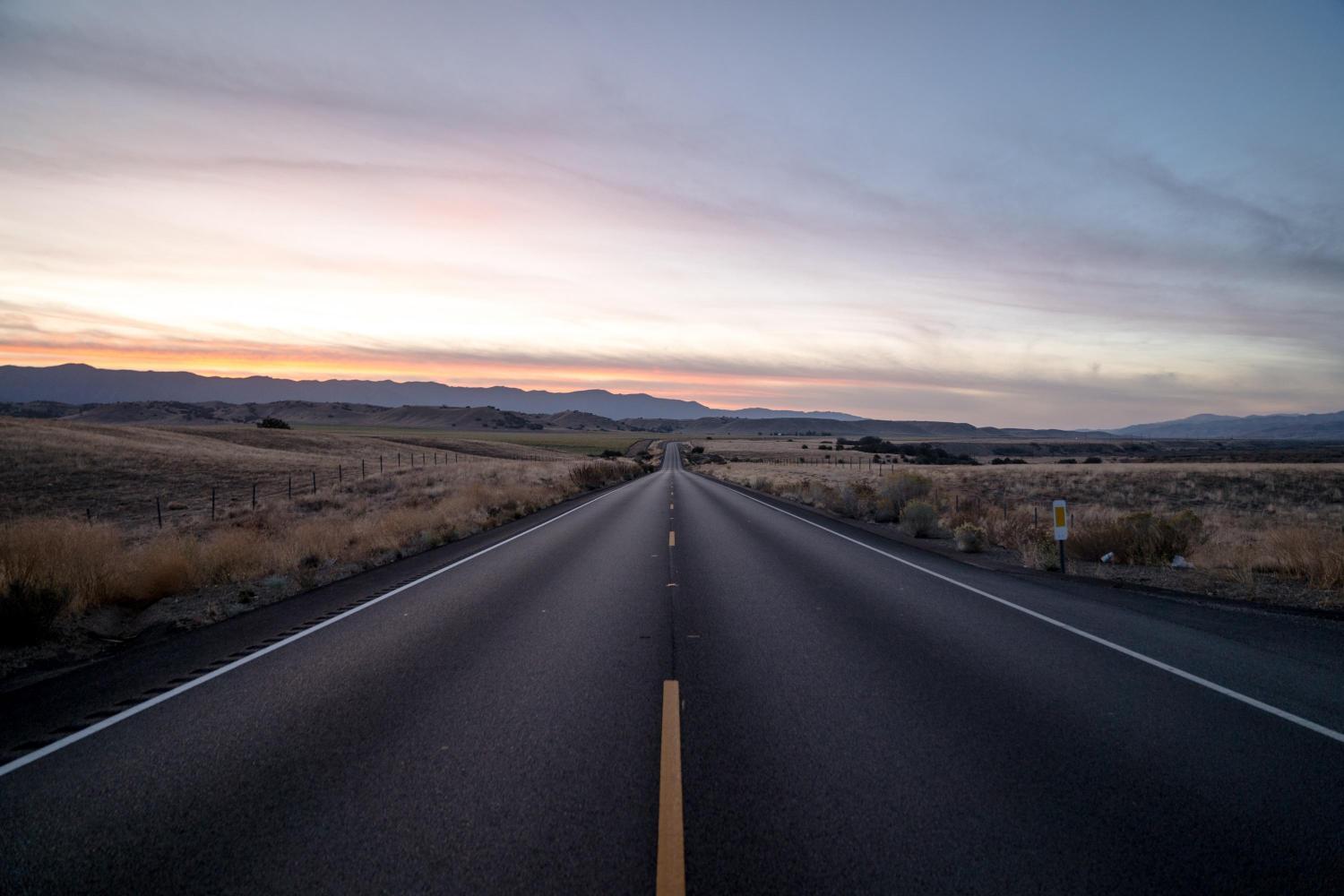

The Business Roundtable, the U.S.’s most influential group of corporate leaders, devised its original statement on the purpose of a corporation in 1997. It was based on the principle that management and directors’ main duty was to maximize profits for the shareholders, who would then decide what to do with those profits.
After recently revisiting the statement, however, the Roundtable has now reenvisioned the relationship between an organization and the world around it. The statement now proposes that a company has a broader responsibility to society that requires it to consider all stakeholders in its business decisions. Noble intentions indeed.
The updated statement of purpose, agreed on by nearly 200 CEOs, is a worthwhile initiative; it acknowledges, from the very top of mainstream business, that there is more to business than profit. It expands a company’s raison-d’etre to non-financial considerations. But as many leaders have noted, more work needs to be done.
From our point of view, there are three buts.
1. Inertia
One may assume that it makes a difference having leadership that’s committed to the statement of purpose. But is this actually the case? We used Datamaran to conduct an analysis of the topics discussed in the purpose statement of signatories' annual disclosure over the last five years.
The graphic below shows the level of emphasis* Business Roundtable and S&P 500 companies have put on specific topics in their annual financial reports, sustainability reports and SEC filings over the last five years. We’ve found that there isn’t any drastic difference between the disclosure patterns of companies who have signed up, and those who haven’t.
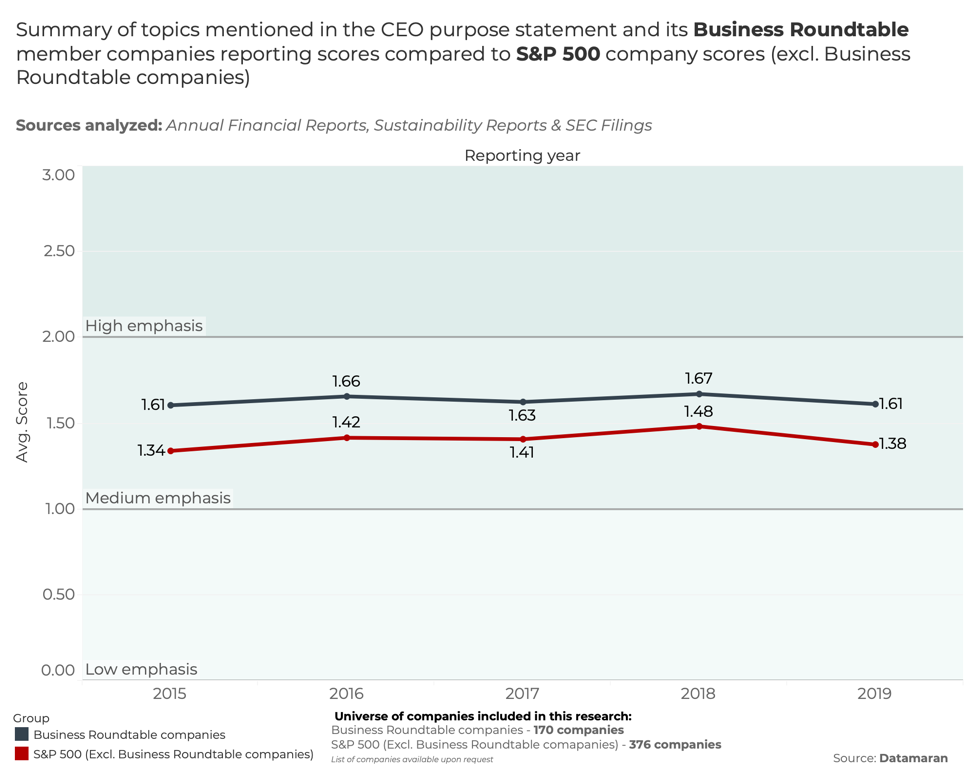
Business Roundtable companies aren't more “committed” to deliver on the purpose statement than the S&P 500, based on their actions so far. One may argue it's early days as the statement has just been made, but we are yet to see any action. You can be part of the initiative, but if you don’t perform the right actions to support it, you’re no different to those who aren’t part of the initiative.
2. Coverage
The issues Business Roundtable CEOs indicate are very ‘social’ in nature. The environmental action component seems to be largely omitted from the statements, which makes the purpose incomplete and biased. We support the drive, but other elements of value creation should be included too, and viewed holistically to see how companies have the greatest net impact.
It’s great that the Business Roundtable is trying to take the lead and identify ways companies create value, but there should be a more holistic way of recognition – multiple capitals. It’s in the broader framework and we can measure it.
3. Assurance
I am still not convinced non-financials are taken seriously. One good way of confirming that a company is committed beyond profit is to have its non-financial disclosure assured. Sadly though, this is by no means a given: our data tells us that in 2019, 71 companies have published a sustainability report, with 32 being assured (45%). Last year, 40 of 106 published sustainability reports were assured (38%). There was next to no movement in the previous three years, with the figures standing at 42% in 2017, 42% in 2016 and 43% in 2015. Sustainability disclosure has started heading in the right direction this year, but there’s still a lot to do.
Takeaways
Grand statements certainly have their place. They help you to articulate noble intentions and communicate your stance to the world. They allow you to create fellowship with likeminded people and work together to make a difference. That is the opportunity now presented to nearly 200 CEOs.
Obviously, this isn’t the first such statement committed to paper. What makes the statement of purpose different to the SDGs (Sustainable Development Goals) for example? How do these various statements of good intent relate to each other? Is commitment to one particular framework (or different parts of different frameworks) more credible than commitment to another?
CEOs will need to be clear on who precisely will take responsibility for the statement of purpose: whether it’ll be the sole domain of the C-suite or whether the shareholders, financial institutions or other groups are able to commit.
The statement of purpose is a step in the right direction, but ultimately, talk is cheap. If they really do believe that their businesses are about more than just profits, now is the time for some CEOs to start putting their money where they mouth is.
Image credit: Jeremy Bishop/Unsplash
Editor’s Notes:
* Emphasis: ‘High,’ ‘medium,’ ‘low’ and ‘no mention’ are the emphasis scores that are used to assess the level of emphasis each company puts on a specific topic in their corporate reports. The emphasis takes into account a number of variables, including but not limited to the number of times the topic is mentioned, its location (e.g. CEO letter) and more. For example, high emphasis topics are found a large number of times in a source and/or in key sections. Whereas low emphasis topics appear only rarely in a source.
In the Wake of Climate Week, Here’s a Future Roadmap for Forests


As we were often reminded during the recent Climate Week events, forests are in full retreat around the world—and their loss has dire implications for countless species, including us.
According to a recent report, populations of forest-living birds, mammals, amphibians and reptiles monitored by World Wildlife Fund (WWF) have declined by an average of 53 percent, in less than a single person's lifetime. For skeptics still looking for the canary in the coal mine, look no further. From accelerated climate change to increasing resource scarcity and infringement on human rights, the impacts of deforestation and land conversion represent a clear and present danger to human health and well-being. And we’re running out of time to turn the tide.
Nearly 500 companies have committed to eliminating deforestation and human rights violations from their supply chains, but precious few are currently on track to meet their 2020 deadlines. Many have struggled with the “how,” their efforts stymied by confusion over definitions for key terms and methods for implementing commitments and measuring progress.
But now, as we approach the 5-year anniversary of the New York Declaration on Forests – the global pledge to end deforestation from agricultural supply chains by 2020 – WWF and partners have created the roadmap that companies have been looking for.
This roadmap for avoiding deforestation and land conversion comes at a critical time. Right now we’re on course to lose an area of forest over twice the size of Texas by 2030. Historically, agriculture has been the biggest culprit, with just a few commodities—including beef, soybeans, wood and palm oil—responsible for most conversion.
The race to expand production, rather than doing more with less by intensifying production on already-cleared land, risks sacrificing one of our most effective tools against climate change. Every year, forests soak up roughly 2 billion tons of carbon dioxide from the air and store it in the ground. When we lose forest, we lose capacity to sequester more carbon and release previously stored carbon back into the atmosphere. Indeed, deforestation is the second largest source of CO2 emissions after the burning of fossil fuels.
Forests also help regulate Earth’s hydrological cycle. Deforestation plays havoc with this natural weather engine, producing shifting rain patterns that have already impacted agricultural productivity in many regions of the world.
Furthermore, forests support a wealth of biodiversity and natural resources. They are home to eight out of ten land-dwelling species and 300 million people, and provide a source of income for over a billion more. Unchecked deforestation threatens mass extinction and unprecedented economic upheaval.
Thus far, the progress companies have made toward more sustainable production falls short of what’s needed to avoid catastrophe. Many companies that have committed to no deforestation in their supply chains have cited lack of clarity over definitions, metrics, tools and other key principles and guidelines. These companies reached out to the non-profit world for assistance. Over the course of two years, WWF joined with more than a dozen environmental and social groups to design the Accountability Framework. It provides the implementation guidance companies need to close the gap between ambitious commitments and tangible results.
The Accountability Framework shows companies how to establish, implement, and monitor progress on their commitments—and it helps them choose the right tools for the job. It also lays out how they can respectfully and effectively engage indigenous peoples, local communities and smallholder farmers in the process. And, critically, the Accountability Framework makes clear the expectation that companies will go beyond their supply chains by collaborating with other stakeholders in sector-wide or landscape-wide initiatives aimed at protecting or restoring forest habitats.
We cannot curb global warming and stem the alarming loss of biodiversity without decoupling production from deforestation and land conversion. The Accountability Framework provides a blueprint for companies to do exactly that. But even the best-laid plans are for naught if companies can’t summon the will to drive truly transformational change. "I don't know what I'm supposed to do" is no longer an excuse for inaction.
Again, virtually no companies are likely to meet their original 2020 deadlines. But what they do over the next year is still critical. At the UN Convention on Biological Diversity in Beijing next October, world leaders will hopefully agree to a New Deal for People and Nature, a global pact to stop biodiversity loss that would complement the climate goals of the Paris Agreement and the forest goals of the New York Declaration on Forests. Between now and then, companies can leverage their considerable influence in support of this New Deal. More importantly, companies can lead by example, demonstrating with their own actions in line with the Accountability Framework that rapid progress is possible.
Image credit: Kevin Ortiz/Unsplash
After Climate Week: Sustainable Finance for the One Percent


TriplePundit has been covering the U.N. General Assembly and Climate Week NYC for the past few weeks. You can follow our coverage here.
Some in the financial services industry seem to have just awakened to the realization they need to assess their risks. This shift in thinking is due in part to the growing awareness of the Task Force on Climate Related Financial Disclosure and a grasp of its guidelines. It might also dawn on those same bright minds amongst the one percent that addressing their risks involves a flight of capital from the most vulnerable places and, thus, a knock-on effect of increasing vulnerability and disparity between rich and poor.
But not yet.
Instead, the financial industry’s top brass speaking at HSBC’s “Financing a Sustainable Future” event, part of last week’s Climate Week in New York, frequently centered on de-risking and disclosure, given the negative impacts of climate risks on banks, stock portfolios, consumer markets and real estate.
Those focusing on material loss to portfolios – rather than such loss to the world’s most vulnerable – were the European Commission’s Network of Central Banks and Supervisors for Greening the Financial System (NGFS), Bloomberg’s special advisor to the Chairman as well as its global head of sustainable business and finance, the head of sustainable finance at the Global Policy Initiatives Institute of International Finance, Moody’s infrastructure finance expert and the International Finance Corporations’ climate business head.
What does all this mean? It’s simple: Those facing disproportionate vulnerability to climate hazards – the global majority – will see less infrastructure investment, job access and social services. In effect, in the sustainable finance world of these big thinkers, stranded assets are ignored. And I don’t mean coal-fired power plants. When a flight of capital occurs from places facing climate hazards, what is stranded are human beings – members of our community left homeless, without jobs, without schools and without modernized infrastructure.
Last year, I asked this question: Is TCFD Guidance Exacerbating Social Inequity? And suggested that the Governor of the Bank of England, Mark Carney, go further with his claims about the “tragedy of the horizon.” Other experts are acknowledging this issue.
The private sector-led Coalition for Climate Resilience Investments launched by Willis Towers Watson and the World Economic Forum at last week's General Assembly includes an aim to provide “support for climate vulnerable geographies to attract investment and prevent capital flight as climate risks become more evident.” Further, in a paper authored by Climate Finance Advisors for UNEP-FI and the Global Commission on Adaptation, Delivering Finance Today for the Climate-Resilient Society of Tomorrow, global finance system experts point this out:
“Identifying the financial implications of climate risks will create enormous opportunities for profitable investment by all types of investors, including both public and private finance. However, the same understanding may also trigger potential capital shifts or flight from the poorest and most vulnerable communities and countries, those most in need of investment in adaptation and resilience.”
They add: “Governments are likely to require the expansion of safety net programs for the poor and most vulnerable.”
Each of their recommendations could be reinterpreted with the aim of decreasing disproportionate risk, including, for instance:
- Accelerate and Promote Climate-Relevant Financial policies [that explicitly protect the most vulnerable].
- Develop, Adopt, and Employ Climate Risk Management Practices [that explicitly reduce risk to vulnerable populations].
- Develop and Adopt Adaptation Metrics and Standards [including benefits gained by vulnerable populations]
CFA’s findings influence the Global Commission on Adaptation report to lead with this:
“Climate change could push more than 100 million people within developing countries below the poverty line by 2030. The costs of climate change on people and the economy are clear. The toll on human life is irrefutable. The question is how will the world respond: Will we delay and pay more or plan ahead and prosper?”
I think the finance leaders speaking enthusiastically at the HSBC event have an answer to that question: They are working to ensure prosperity. Let’s plan and act on it being for the global majority, not just the one percent.
Image credit: United Nations/Facebook
Sustainability Champion Says Progress Requires Unlikely Collaborations


Editor's Note: This article series is sponsored by Philip Morris International.
When Hasan Youness was growing up in Lebanon, he often ran errands for his parents. But there was one thing he wouldn’t do: get cigarettes for his father. “Get your own cigarettes, dad, and feel free to use the balcony,” Youness recalled saying, as recounted in a September blog post. “Didn’t you see the picture of the lungs of smokers in the science book?!”
That is why it is surprising that, today, Youness has engaged in a dialogue with Philip Morris International (PMI) and formed an unlikely friendship with its social impact and sustainability lead, Jennifer Motles. His motivation is one he says the tobacco giant shares: creating a world without cigarettes.
Youness is a strategic advisor to the U.N. Global Compact in Lebanon and professor of strategic management and sustainability at Lebanese International and Notre Dame Universities. He’s also a leading voice for the U.N. Sustainable Development Goals (SDG), including SDG 3, Good Health and Wellbeing. For him, there is no other way to achieve the goal than by working with all stakeholders involved—even those who others demonize.
“When it comes to making progress on the SDGs, we cannot afford to exclude anyone,” Youness said in an interview with TriplePundit, during which he was clear that he is not an employee or consultant for PMI. “If an organization is engaged and demonstrating that they're making a real effort, then it’s imperative to include them in the discussion.”
Working toward a smoke-free future
PMI, known for its Marlboro brand epitomized by the tough-looking smoking cowboy, says it is committed to accelerate the end of cigarettes, for the benefit of consumers, the company and society. It proclaims on its website that it is shifting resources to transform its business and become a smoke-free technology leader as quickly as possible with new offerings such as IQOS, a heated tobacco product.
“There is no substitute for quitting, and regulations should continue to dissuade people from starting to smoke, as well as encourage cessation,” Motles of PMI wrote in an article co-authored with Youness, which appeared in the Global Goals Yearbook 2019.
“Yet, for the hundreds of millions of men and women globally who will otherwise continue to smoke, PMI’s goal is to switch current smokers to nicotine-containing products that are scientifically substantiated as better choices than continuing to smoke. Even though they are addictive and not risk-free, these products have the potential to significantly reduce the individual risks and population harm when compared to cigarette smoking.”
To be clear, cigarettes are still, by far, the largest part of PMI’s business, but Motles says this is changing, as PMI reallocates its resources—including 92 percent of its global research and development budget and 60 percent of its commercial expenditure—toward smoke-free products. She also notes in the Global Goals Yearbook that the company is striving to help at least 40 million people who would otherwise have smoked cigarettes to switch to its smoke-free products by 2025, reducing the number of PMI cigarette smokers by a total of 55 million.
PMI has developed business metrics to track its progress, which are included in its annual sustainability reports. Youness, whose role often centers around guiding change at companies like PMI, says these metrics are critical to build credibility and indicate the company is truly committed and not just putting forth feel-good communications. “Often, [organizations] may want to change,” he said, “but don’t know exactly how.”
“I know there is a huge degree of skepticism and bias about the role we can play,” Motles added. “And, change doesn’t happen overnight. It comes from transparency, disclosure and patience.”
An unlikely dialogue is born
Youness was as surprised as anyone that he would be sitting at the same table with a tobacco company. It started in 2015, when he met Motles while they were both students at Harvard Business School.
“Jenny works for a company which is a major contributor to health problems and diseases caused by smoking cigarettes,” he recalled on his personal blog. “I always thought of her role and company as a contradiction in terms. What has sustainability to do with tobacco? I used to be skeptical that this industry could even merit my asking of the question, let alone be considered as a potential problem solver.”
But the two began to talk, Youness sharing his concerns and criticisms and Motles her company’s aspirations and actions. “When I found out they had changed their purpose [in 2016] to the aim of accelerating the end of cigarettes, my perception started to change,” Youness wrote. “I realized that this awful company could actually serve a valuable purpose.”
For Motles, the key to their relationship was finding common ground, without which, she admits, justifying any partnership can be a challenge. But she told us she firmly believes that where common ground exists, collaboration—even between former adversaries—is critical.
”We’ve learned from history that when we don’t include every stakeholder that plays a part in an issue, the solutions are not viable or sustainable,” she told TriplePundit. “If we want to create change that is sustainable, unfortunately for some, the only way is to sit everyone around the table and define the standards and role that each of us needs to play to get there. I know it will be hard and uncomfortable, but sometimes it is that discomfort that brings change.”
Image credit: Pexels
2019 Climate Action Summit: Businesses Are Pulling Governments Toward a Net Zero Economy


By: David Wei, Director, Climate, BSR
At the 2019 UN Climate Action Summit, the global community expected national leaders to announce new, more ambitious commitments to combat climate change. While the Summit included a handful of positive announcements—Indian Prime Minister Modi announced a new target of 450 gigawatts of non-fossil energy, German Chancellor Merkel launched a EUR 50 billion climate action plan, several countries increased their contributions to climate finance, and 77 countries committed to net zero emissions by 2050—the ambition of these announcements does not match the urgency that climate change demands.
This lack of ambition arrived as the world is demanding action: millions of students and supporters marched last Friday across the world in the Global Climate Strike, and report after report this year— on biodiversity, on land, on climate adaptation, on oceans— has underscored the urgency to act.
Our goals for the next, decisive decade will determine whether we succeed or fail. To fulfill the promise of the Paris Agreement, nations must deliver much stronger climate targets ahead of next year’s pivotal COP26. At the Summit, national leaders failed to change our path towards over 3°C of warming by the end of this century—and yet, climate action from the private sector accelerated.
The Summit underscored that business must forge ahead with building our net zero economy. From the stark gap between national announcements and business action, I heard three messages:
- To national leaders and governments: Businesses are showing you how to build the net zero economy. Without improved short-term targets and policies, a promise to reach net zero by 2050 is not enough.
- To businesses: The argument that governments must go first is truly dead. Companies must generate long-term value for their investors, win the war for talented millennials who demand purpose, and attract consumers who demand sustainable products.
- To businesses: You may already work hard to reduce your operational emissions and manage climate risks. You may already engage your suppliers and make energy-efficient products for your customers. But if you do not actively influence governments to set more ambitious climate policies, it will not be enough.
Indeed, it is in the private sector where we see momentum for climate action growing with increasing urgency. Five years ago, the Science Based Targets initiative did not exist; today, 647 companies are committed to targets in line with the Paris Agreement. RE100 did not exist; today, over 190 companies are committed to sourcing 100 percent renewable electricity. The We Mean Business coalition, co-founded by BSR, did not exist; today, its Take Action platform features over a thousand companies taking climate action. All in the time of a single election cycle.
Just as building a net zero economy requires the whole of government, building a net zero value chain requires every company department.
At the Summit, business action broadened to more industries. Allianz CEO Oliver Bäte announced a Net Zero Asset Alliance, representing US$2.4 trillion in assets. The Getting to Zero Coalition, for which BSR’s Clean Cargo is a knowledge partner, aims to deploy commercially viable zero emission maritime shipping by 2030. Representatives of the steel, aluminum, and cement industries spoke to their contributions to a net zero pathway. Danone CEO Emmanuel Faber launched the One Planet Business for Biodiversity coalition at a time when one million species are under threat of extinction.
Climate action also deepened within companies: 87 companies with a combined market capitalization of US$2.3 trillion committed to setting climate targets across their operations and value chains aligned with limiting warming to 1.5°C and reaching net zero emissions by 2050.
At BSR, we see how deep climate action can go. Sustainability professionals are working with their operations counterparts to decarbonize production, with their procurement counterparts to decarbonize supply chains, with their risk management counterparts to manage climate risks, and with their finance counterparts to set up climate innovation funds. Just as building a net zero economy requires the whole of government, building a net zero value chain requires every company department.
These companies realize that climate mitigation and adaptation will bring tremendous opportunities to them or to their competitors. Today, it is unfortunate that businesses understand this more clearly than national governments do. But businesses can help to close this gap by calling for more ambitious climate policies by COP26 in November 2020.
Originally appeared on BSR and the 3BL Media newsroom.
Image credit: Juan Di Nella/Unsplash
Smithfield Moves to a More Sustainable Supply Chain, Starting with Animal Feed
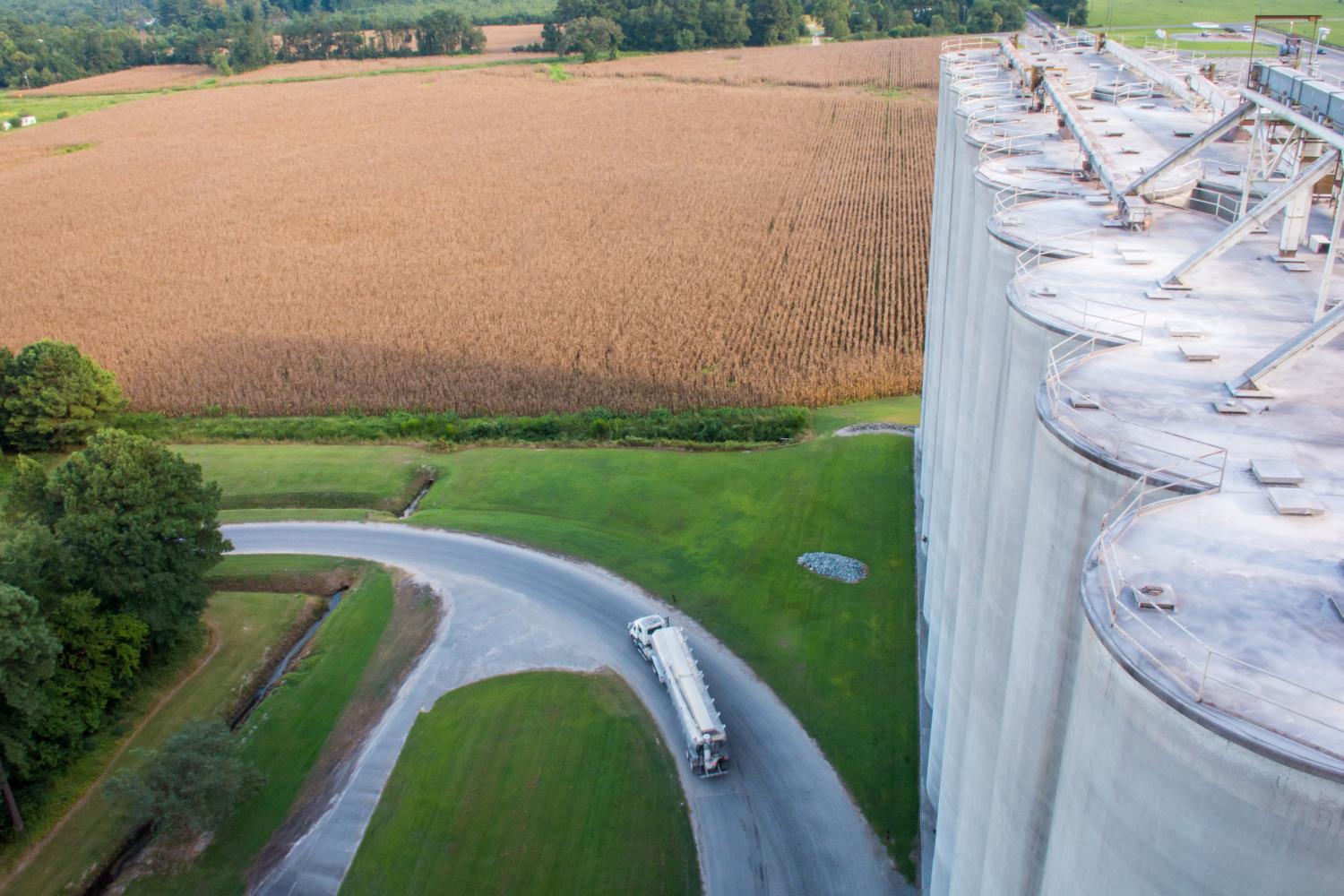
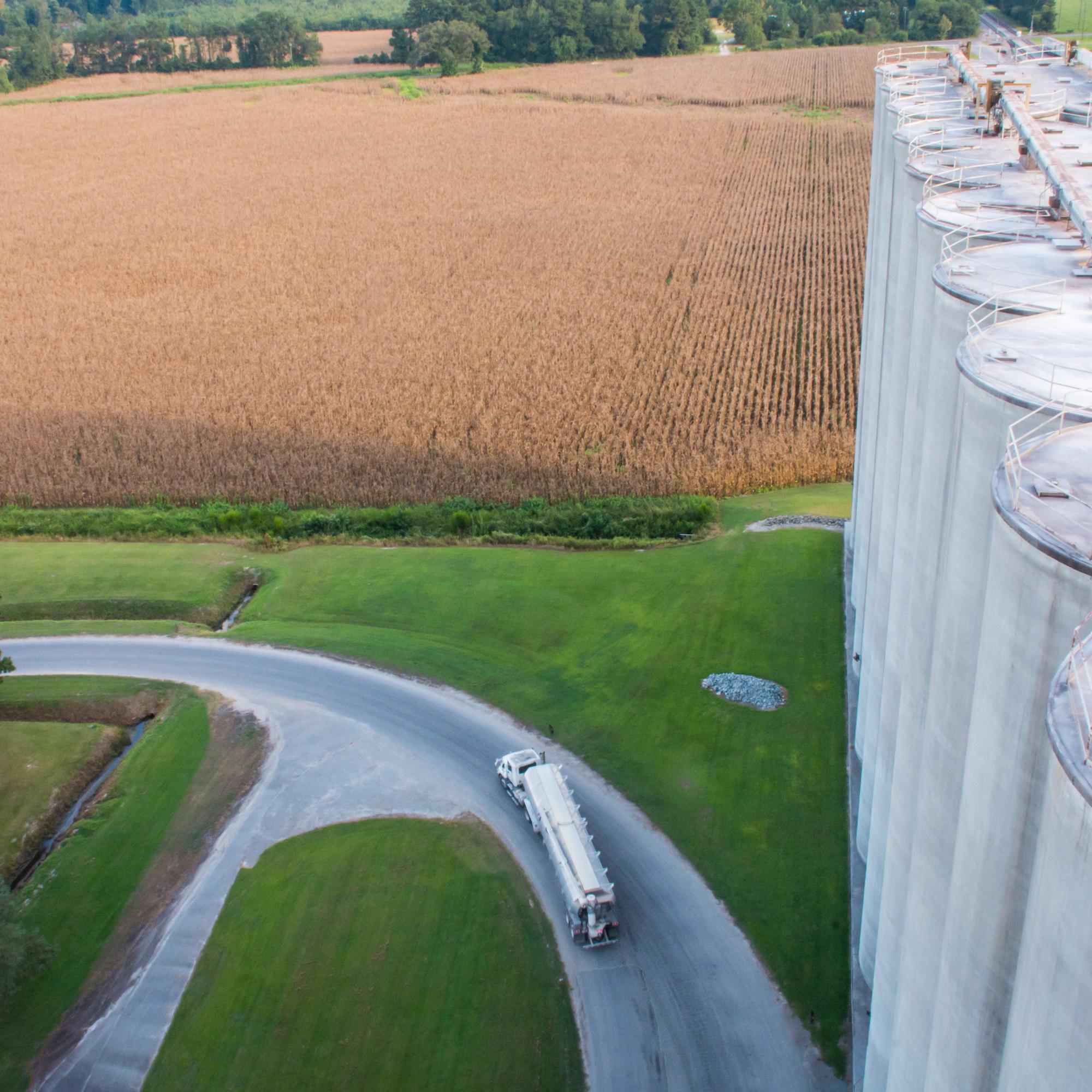
This article series is sponsored by Smithfield Foods and produced by the TriplePundit editorial team.
While the discussion around climate change often focuses on the two primary sources of global greenhouse gas (GHG) emissions—power generation and transportation—agriculture is also a key driver. The food and agriculture industry represents between 10 and 12 percent of global GHGs, according to the Intergovernmental Panel on Climate Change, and the U.N. Food and Agriculture Organization estimates that emissions in the segment are growing.
Smithfield Foods is a major player in global agriculture. It is the world’s largest pork processor and hog producer, with sales exceeding $15 billion in 2018. The company’s supply chain includes numerous farms across the United States and Europe, and it has customers in 44 countries on every continent.
With that much scale and scope, Smithfield is in a unique position to have a broad sustainability impact—and it says it’s making significant progress on this front. In February, for example, the company announced a major milestone: sourcing 80 percent of the grain used in its animal feed from suppliers who use more sustainable farming practices. Grain production is the first step of Smithfield’s vertically integrated supply chain and accounts for 15 to 20 percent of the company’s GHG emissions. “This was a meaningful early step aimed at our own supply chain, and a first in our industry,” said Stewart Leeth, vice president of regulatory affairs and chief sustainability officer for Smithfield.
This effort started five years ago through conversations with Walmart and the nonprofit Environmental Defense Fund (EDF), Leeth said. Together, the three organizations highlighted fertilizer use on grain fields as an area where they could have a meaningful, positive environmental impact. “The issue there is that over-application of fertilizer creates runoff to surface waters and results in air emissions, so EDF was keenly interested in trying to find out ways to address that,” Leeth told Triple Pundit.
Fertilizer overuse has been a well-known problem for years, responsible for harmful impact on soil, health and the environment. But addressing fertilizer use in the grain supply chain is not a low-hanging-fruit type of task. Smithfield sources grain from hundreds of farms across the country, and reducing fertilizer use meant working with each of those farmers on education, technology training and proper management.
To help its suppliers adopt more sustainable practices, Smithfield hired on-staff agronomists to travel to farms and demonstrate strategies for responsible fertilizer use. The company also gave farmers access to new technological tools—such as Adapt-N, a nitrogen management solution, and others that help farmers manage on-farm conservation.
Smithfield has already worked to implement better conservation practices on about 560,000 acres of farmland in the U.S. Southeast and Midwest. In the end, this program benefits not just the environment, but also farmer well-being.
“For farmers, what it meant was less fertilizer use and less costs going into the field” Leeth said. “On the backside, if [farmers use] the soil conservation technology, they might have better yields next year.” Still, some farmers were reticent to do things in a new way. “That took time, to communicate and to build trust,” Leeth told us.
Achieving the 80 percent target is meaningful, exceeding Smithfield’s original goal of 75 percent, but it's just one step toward Smithfield's broader goal of reducing absolute greenhouse gas emissions by 25 percent by 2025 and cutting its total footprint by more than 4 million metric tons of CO2 equivalent. These long-term trajectories are driven by the company’s values and also, increasingly, market demands, Leeth said.
“Our sustainability platform is broad and covers a lot of areas—and necessarily so, because we are in the food industry, and people are interested today in how food is made,” he told us. “We’re heavily focused on environmental improvement.”
Along with efforts to improve the grain supply chain, Smithfield is looking to further cut emissions by turning manure methane emissions into biogas. The company is investing hundreds of millions to install methane capture technology on 90 percent of its hog finishing spaces in North Carolina, Utah, and Virginia, and nearly all in Missouri. With methane being 84 times more potent than carbon dioxide in terms of short-term warming potential, and farms a key source of these emissions, efforts like these could be vitally important to achieving short-term global climate goals.
There’s a bigger opportunity, too–pushing for broader, industry-wide change. As one of the largest companies in the agriculture and farming business, and with a broad and vertically integrated supply chain, Smithfield hopes to show the entire industry that sustainability is not only achievable, but also financially beneficial.
“We like to take leadership positions,” Leeth told us. “Other folks see that, and see it can be done, and it’s moving our industry in the right direction. If you have a big actor like us, showing the pathway to success, I think that inspires and encourages others to participate.”
Image courtesy of Smithfield Foods